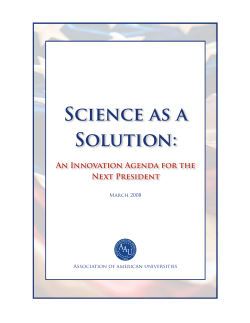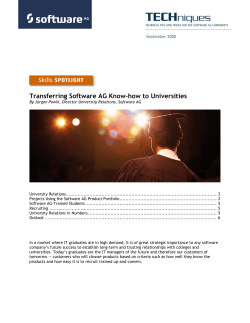
2011 RESEARCH REPORT Presented to the Board of Regents
2011 RESEARCH REPORT Presented to the Board of Regents Tim Mulcahy, Vice President for Research December 9, 2011 PREFACE Each year in December the Vice President for Research provides the Annual Research Report for the Board of Regents, summarizing the University’s research metrics for the past year, documenting the trends in research productivity and benchmarking the University’s performance and ranking among its peer group. This later metric, based on the ranking data published by the National Science Foundation for R&D expenditures for the nation’s research universities, is the most commonly recognized basis for comparison among research intensive universities depending as it does on the compilation and analysis of responses to a standardized national survey tool. As such, analysis of the University’s performance on the basis of the annual NSF R&D expenditure report has been a prominent feature of the annual report to the Board and a basis for measuring progress toward the U’s aspirational goal to be one of the top public research universities in the world. In the first revision to the NSF Higher Education Research and Development Survey in years, the NSF last year made several significant changes to the Survey. One notable change that will have an impact for the U and the assessment of its performance relative to its peer group is the NSF’s decision to split out the research data for university systems into statistics for each individual research institution in the system. As a consequence, the data for the University of Minnesota-Twin Cities and that for each coordinate campus will henceforth be reported separately. As a result of the widespread changes introduced in the NSF Survey this past round and a correspondingly longer verification process for data submitted by the nearly 700 universities included in the Survey, NSF will not publish the official Survey results for FY2010 until sometime after the new year – postponing the traditional October-November publication date. As a consequence, we do not have access to the official data we routinely use in our December Annual Report to the Regents. Given the heavy reliance on this data set for analyses included in our Annual Report we have elected to deviate from our standard practice of providing the Board with a printed hardcopy of the Annual Report, preferring to commit the final report to print only after the official NSF Survey data are published. Although we do not have confirmed statistics for the other academic participants in the NSF Survey, we have our own NSF Survey expenditure and award data and have access to similar data submitted by other AAU universities through AAU’s data exchange program. While these data are not “official” and changes have been known to occur between submission to the data exchange and publication of the Survey results, we are confident that the available data will provide reasonable surrogate measures to permit our traditional comparative analysis pending availability of the official Survey results in early 2012. In addition to my traditional rejoinder that no single measure or set of currently available measures can accurately or even reasonably capture the full measure of a great research university, the Regents are also cautioned to be mindful of the preliminary nature of the results and analysis included in this report. SPONSORED RESEARCH AWARDS University of Minnesota faculty and staff competed successfully for $769 million in sponsored research awards in FY2011 (Figure 1). The award total was down $53 million (7%) from the total for FY2010. Grant support from ARRA funding declined as expected, netting $57 million less in 2011 than in 2010. After factoring the impact of declining ARRA funding on the award total, non-ARRA awards were actually $4 million greater than for FY2010. Figure 2 and 3 display sponsored award data by source and collegiate unit, respectively. The sources of funding have remained relatively constant over the past with federal agencies, dominated by NIH and NSF, accounting for 72% of all sponsored research. Overall distribution of awards across collegiate units is similarly consistent, though significant declines in funding to the Medical School, College of Science and Engineering and School of Public Health account for the majority of the decline in awards in the past year. Much of this decline, in turn, reflects the overall decline in ARRA funding. Award growth of 10% or more were recorded by the College of Education and Human Development, College of Biological Sciences and the College of Liberal Arts. FIGURE 1 | FY2011 SPONSORED AWARDS ARRA Awards 2011 2010 $0 $200 $400 (Dollar amounts represented in millions) $600 $800 $1000 FIGURE 2 | AWARDS BY SOURCE Other DHHS $32.8 DOEd $25.8 DOD $17.4 DOE $14.6 Other Federal $35.7 NIH $305.3 DOA $38.9 Business & Industry $46.4 State & Local $50.6 NSF $82.5 Other Private $119.1 (Dollar amounts represented in millions) FIGURE 3 | AWARDS BY COLLEGE UMC, UMD, UMM, UMR $20.7 Sr VP Systems Academic Admin $21 CLA $18.6 Other $13.4 Other TC Provost $11.9 Medical School $206.7 CBS $26.6 Dentistry, Nursing, Pharmacy & Vet Med $39.7 CEHD $40.5 Other Health Sciences $68.8 CSE $133.3 CFANS $74.6 Public Health $93.3 (Dollar amounts represented in millions) SPONSORED AWARDS BY CATEGORY (10 year trend) The bar chart (Figure 4) and table below (Table 1) summarize the distribution of University sponsored research awards by major sponsor category for the past 10 years. Despite some year-to-year variations, the proportion of funding from the major source categories has remained relatively stable over the past decade, with the introduction of ARRA fund in 2009 being a notable exception. The significant impact of ARRA funding is evident in the very sizeable growth in awards total registered in FY2010. As noted in last year’s Annual Report, some disruptions in award disbursements from federal agencies occurred as they scrambled to deal with the short fund distribution time limits imposed by the America Recovery and Reinvestment Act (ARRA). This resulted in delays in issuance of some 2009 award notices, contributing in part to the drop in awards recorded in that fiscal year. When this anomaly is taken into account, awards show a steady upward trend over the past 8 years. FIGURE 4 | TEN YEAR AWARDS BY CATEGORY $800 Federal ARRA $700 Other Private State & Local $600 Business & Industry $500 Federal Non-ARRA $400 $300 $200 $100 $0 2002 2003 2004 2005 2006 2007 2008 2009 2010 2011 (Dollar amounts represented in millions) 2002 2003 2004 2005 2006 2007 2008 2009 2010 2011 Other Private 50.6 51 70.5 81.6 68.8 93.6 103.2 108.7 116.5 119.1 State & Local 66.6 74.1 34.3 32.8 62.8 55 75.9 46.8 62.2 50.6 Business & Industry 39.3 48.8 41.7 52.7 50.7 47.8 52.8 41.7 45.9 46.5 42.7 131.9 74.2 Federal ARRA Federal non-ARRA Total 370.1 339 377.1 394.1 393.8 422.8 442.9 366.6 467.4 478.9 $526.6 $512.9 $523.6 $561.2 $576.1 $619.3 $674.8 $606.5 $823 $769.1 TOP 20 COMPARISON GROUP Table 2 lists the ranking of the top 20 public research institutions in the United States according to the three metrics we have reported to the Board over the past seven years. The universities included in the Table are listed in rank order according to preliminary NSF Survey research expenditures for 2010 (see Preface). Each institution’s corresponding 2010 rank according to the Center for Measuring University Performance (Arizona) and the Shanghai Academic Ranking of World Research Universities are also listed. TABLE 2 | TOP 20 PUBLIC INSTITUTIONS NSF ¹ 2010 Center for Measuring U Performance ¹ 2010 Public Public World US US ¹ Public Michigan 1 Group 1 22 18 7 Wisconsin, Madison 2 Group 1 19 17 6 Washington, Seattle 3 Group 2 16 14 4 UC San Diego 4 Group 3 15 13 3 UCLA 5 Group 1 12 10 2 UC San Francisco 6 Group 1 17 15 5 Pittsburgh 7 Group 2 57 38 20 Minnesota, Twin Cities 8 Group 2 28 20 9 Penn State, U Park 9 Group 2 45 31 15 UNC, Chapel Hill 10 Group 1 42 30 14 Ohio State 11 Group 2 63 41 23 UC Berkeley 12 Group 1 4 4 1 Texas A&M 13 Group 4 100 53 30 Florida 14 Group 1 72 43 24 UC Davis 15 Group 4 48 33 17 Georgia Tech 16 Group 2 102-150 54-68 31 UTX M.D. Anderson Cancer Center 17 Group 3 151-200 69-89 52 Texas 18 Group 3 35 27 12 Arizona 19 Group 3 80 47 27 Purdue 20 Group 5 61 40 22 Shanghai ¹ 2010 SOURCES *2010 AAU Data Exchange pending publication of the National Science Foundation, Survey of Research and Development Expenditures at Universities and Colleges, FY 2010 The Center for Managing University Performance, The Top American Research Universities, 2010 Shanghai Ranking Consultancy, Academic Ranking of World Universities, 2010 NSF R&D EXPENDITURES A comparison with last year’s NSF R&D Expenditure data reveals some shifting in relative rank among the universities included in the top 20 list, though the roster of players has remained relatively unchanged. The University of Minnesota retained its eighth-place ranking among public research universities in FY2010. Figure 5 presents the research expenditure data for the top twenty public research universities for FY2010. It is important to note that the research expenditure data for the University of Minnesota represents only the research expenditures for the Twin Cities campus. Unlike previous years in which the U’s total represented the aggregate research contributions from all campuses in the System, the revised Survey methodology now considers each campus individually. The FY2010 total for the University of Minnesota System would be $808 million rather than the $786 million reported in Figure 5 had the traditional methodology been utilized in FY2010. FIGURE 5 | 2010 NSF R&D EXPENDITURES Michigan Wisconsin, Madison UC San Diego UCLA UC San Francisco Minnesota, Twin Cities Penn State, U Park UNC, Chapel Hill Ohio State UC Berkeley Texas A&M Florida UC Davis Georgia Tech UTX M.D. Anderson Cncr Ctr Texas Arizona Purdue $0 (Dollar amounts represented in millions) $200 $400 $600 $800 $1000 $1200 TECHNOLOGY COMMERCIALIZATION The Office for Technology Commercialization continued its strong performance and productivity in FY 2011. The benchmark metrics we have adopted to monitor performance in this sector of our mission are summarized in Table 3. In all but one metric category significant improvement over FY2010 was accomplished in FY2011. The notable exception was in the revenue collected from the University’s blockbuster technology – Ziagen – an anti-HIV agent used in AIDS treatments around the world. This trend was expected as the patents on this drug expire. The royalty stream is expected to be exhausted in the very near future. TABLE 3 | UNIVERSITY TECHNOLOGY COMMERCIALIZATION DATA Disclosures FY2007 FY2008 FY2009 FY2010 FY2011 193 217 244 255 250 New U.S. Patent Filings 51 52 65 66 78 New Licenses 77 63 44 67 76 4 2 3 8 9 n/a 281 306 399 457 $65.2 $86.9 $95.2 $83.8 $10.1 $8.5 $7.9 $8.7 $8.6 $10.1 n/a 67 106 171 271 Start-Ups Current Revenue Generating Agreements Gross Revenues Non-Glaxo Revenues Outgoing Material Transfer Agreements According to the annual report issued by the Association of University Technology Managers (AUTM) the University of Minnesota performed well in comparison to its peers in FY2010. The University ranked 6th overall in licensing income, was tied for 15th among all universities with 8 new start-up companies launched and ranked 17th in terms of new licenses executed. All three of these activities have been key priorities for the OTC following our restructuring four years ago and are indicators of significant progress. In July 2011 we conducted an external review of OTC to gauge the effectiveness of the operation three to four years after restructuring. The review was conducted by Director’s from three of the nation’s top university technology transfer programs — Stanford, Columbia and the Wisconsin Alumni Research Foundation (University of Wisconsin, Madison). The reviewers praised the University for dramatic improvements in its approach to bringing research discoveries to the marketplace. Among other findings, the report declared that the U of M “… has an outstanding track record of accomplishments that puts it at the highest ranks of university tech transfer offices,” and noted that “… the office has done so on a much more limited budget and staffing model than most of its peers.” Characterizing OTC’s performance on a par with their own programs they concluded that “The University clearly has much for which it should be proud.” The reviewers also offered recommendations for a number of improvements, and OTC is currently exploring ways to implement them. CONCLUSION Despite a very uncertain funding environment characterized by discontinuance of ARRA funding, declines in the level of federal funding for research, and unprecedented cuts in state support the University of Minnesota continued its robust performance into FY2011, maintaining its competitive standing vis-à-vis peer institutions on a wide range of performance measures. This is a clear testament to the extraordinarily talented research faculty and staff in a broad range of disciplines across our 5 campuses. While many challenges are looming just over the horizon, all indications are that the University of Minnesota will be able to continue to retain, if not improve upon, its standing among the nation’s elite public research universities. In addition to providing a summary of the material included in this report, Vice President Mulcahy will also provide a review of the national funding landscape and its implications for research at the U in the corresponding presentation to the Board. He will also discuss rationale and strategies for forging effective partnerships with business and industry. The presentation will also include an announcement of an exciting new program designed to help make the U the partner of choice for businesses and companies interested in sponsoring research at US universities.
© Copyright 2025





















